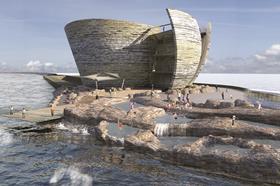Plans including proposal for ┬Ż1.3bn scheme in Swansea now ditched after business secretary says project does ŌĆ£not meet the requirements for value for moneyŌĆØ

The government has pulled the plug on plans for a fleet of tidal lagoon schemes across the UK, saying they are too expensive to use taxpayersŌĆÖ cash.
Speaking in the House of Commons yesterday, energy secretary Greg Clark said the public purse would not be helping bankroll a ┬Ż1.3bn scheme in Swansea being developed by Tidal Lagoon Power Limited.
Three years ago, Laing OŌĆÖRourke was named as preferred bidder for the ┬Ż200m contract to deliver the lagoonŌĆÖs 410m turbine house and sluice structure block.
Work had been expected to start the following year under the direction of Tidal Lagoon PowerŌĆÖs then director of construction and engineering, former Balfour Beatty chief executive Andrew McNaughton.
At the time, OŌĆÖRourkeŌĆÖs project lead on the job, Jonathan Adams, hailed the award: ŌĆ£Today, the Swansea Bay Tidal Lagoon is the talk of the international construction industry and we are thrilled to be playing a part in its delivery.ŌĆØ
But Clark has now said the six lagoons ŌĆō five others were planned round the coasts of Wales, Somerset and Cumbria ŌĆō were not value for money and would be better spent on other schemes such as offshore wind farms.
He added: ŌĆ£The project and proposed programme of lagoons do not meet the requirements for value for money and so it would not be appropriate to lead the company [Tidal Lagoon Power] to believe that public funds can be justified.
ŌĆ£The proposal for the Swansea tidal lagoon would cost ┬Ż1.3bn to build. If successful to its maximum ambition, it would provide around 0.15% of the electricity we use each year.
ŌĆ£The same power generated by the lagoon, over 60 years, for ┬Ż1.3bn, would cost around ┬Ż400m for offshore wind even at todayŌĆÖs prices, which have fallen rapidly, and we expect to be cheaper still in future. At ┬Ż1.3bn, the capital cost per unit of electricity generated each year would be three times that of the Hinkley Point C nuclear power station.ŌĆØ
An independent review back in January last year, carried out by former Tory energy minister Charles Hendry, said the Swansea plan was a ŌĆ£no regrets optionŌĆØ and the government should get on and commit to it.
But Clark said: ŌĆ£If a full programme of six lagoons were constructed, the Hendry Review found that the cost would be more than ┬Ż50bn and be two and a half times the cost of Hinkley to generate a similar output of electricity.ŌĆØ
The Confederation of British Industry said it was disappointed by ClarkŌĆÖs decision and warned it could put off others from pressing on with their own energy initiatives.
Its director for Wales, Ian Price, said: ŌĆ£All major infrastructure projects require large amounts of time, energy and money, only for many to then fail to get the green light. There must be a smarter way of approaching such projects that does not discourage innovative entrepreneurial new firms from entering the marketplace.
ŌĆ£The newly established National Infrastructure Commission for Wales should lead a cross-agency review into all stages of this project and identify ways both governments can speed up the process for future energy infrastructure projects and remove barriers to entry for other firms.ŌĆØ
Once Swansea had been built, other lagoons were planned for Newport and Cardiff and a site across the Severn Estuary at Bridgwater Bay on the Somerset coast. Two more were planned for Colwyn Bay in north Wales and at a site in Cumbria.


























No comments yet